Introduction
This project grew out of a
discussion on www.concertina.net.
Tasmanian player and enthusiast David Hornett happened to mention his
plan to measure up reeds from Lachenal duet concertina No 3316.
Sensing an adventure, I offered to help organise and present the
measurement data. It proved somewhat of a learning curve for both
of us, and you can follow that journey
here. I then felt we should have a place to preserve the final
outcomes, hence this article.
Before we get into the
measurements and analysis proper, some background...
Why is David doing this?
Why my curiosity re reeds? Well ... I ordered a Suttner 2
years ago and am still waiting, figured they can't be too hard
to make. I mean Jeffries was a tinker, and every man and his dog
who worked at Wheatstone's seems to have at some stage taken up
the trade, and then there was Stanley and his clock springs: so
I figured I'd make four, C/G. D/G ... get the drift?
Anyway, then
the learning curve began!! I am now amazed that, with basically
nothing, no background and rather primitive working conditions,
ears for tuners and candles for mid winter light, our ancestors
knocked out such good instruments ... absolutely amazing. Anyway
I have got to the position of reed making.
Now I did a bit of
reading (reeding?) on concertina net and came across the
comments about special hard 'Swedish steel'', "master reed
makers", particularly "Honking" (I assume not some sort of cabaled concertina coding referencing a courtship ritual) and
the such like -- all supposedly only known to Jeffries who
pretty well remains unknown to anyone ... I mean did that jaunty
little fellow in the hat really make concertinas, or did he
assemble components made by others in their misery to gain a
buck?
So I figured I'd find an old Jeffries, fix it and learn a bit
along the way. Now the Jeffries I found needed a few reeds made,
(in fact it needed everything, so I pretty well made most of a
new Jeffries in my workshop dungeon under the house, while the
wife terrified her peace of mind watching Midsomer Murders
above). So, I purchased the Lachenal duet for which you
now have the readout (on ebay. The Duet
girls seem to be the poor siblings of their very sexy folksy,
angly brothers); stole some
of the reeds (the ones missing from your chart) filed them down
and put them into the Jeffries -- I absolutely defy anyone to
tell the difference, and those reeds are not Swedish steel and I
am not a master reed maker!
At about this point I measured all the duet reeds and sent
the measurements off to Terry McGee. AND then I experimented and
put a few Lachenal reeds directly into the Jeffries instrument.
They can be picked as different, but just! (My wife, Masters in
Music, master of most instruments and a wonderful ear player
tells me: "There is no difference, I can't hear it anyway,
people get a bit too obsessional about their instruments, they
sound like concertinas to me.) They 'Honk' but are not as
strong, exactly why the difference I am not sure and have been
to lazy to follow through: but they are a little shorter than
the Jeffries and have therefore a slightly different taper. One
day I will compare the two: but I am absolutely certain it has
nothing to do with 'special Swedish steel' because the reeds I
replaced in the Jeffries were: one brass and one german silver,
(and the top 'E' which was entirely missing, shoe and all) and
they sounded in the box just like Jeffries reeds but softer.
So now, thanks to your insistence, Terry, I am embarking
on a full set of concertina reeds, using your chart as a
guide, and using 5 different thicknesses of blue tempered
steel (rather than two like the Lachenal). In CNC'd shoes
which are fractionally longer and wider than Lachenal
reeds for the same note, and with parallel sides like the
broad reeded Jones (1880), one of which I have, and which,
according to Malcolm Clapp, is the loudest Jones he has
ever heard.
Below are the end actions assembled for the Tassie Tiger
concertinas (blue gum, leaves, Tassie eagle, devils and
tigers with the Tasmanian map thrown in too) I am making (I
am NOT making them to sell, just one for each of the kids
and the wife when I pass the mortal coil - Oh, what a
legacy!?).
And the revived Jeffries with its nice new
Kangaroo skin bellows....
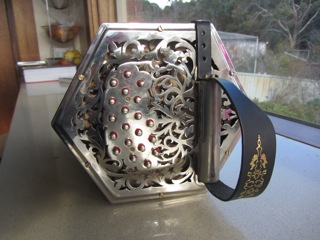 |
 |
| (Purchased this Jeffries some years
back. It came from the Peace Hospice, London. The Lady had
included a note to say it was turned into them after being
found on the banks of the Thames, completely waterlogged in
its leather case, and no one had approached the police to
claim it. Animal glue and water don't go well together, it
literally came as bits in its leather case. |
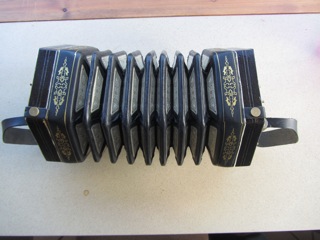 |
| This last
picture is of the reeds from the Lachenal Duet. The reed closest to the needle
point micrometer is the odd one out in the set -- longer
reed, narrower shoe, slightly different taper: I would put
what money I have on it being a Jeffries reed. |
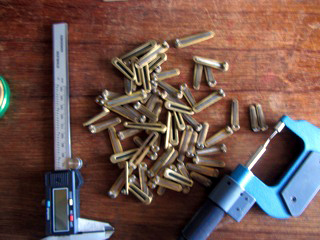 |
And the instrument?
| The reeds come from a Lachenal Crane "Triumph" Duet
concertina No 3316, believed to be from around 1913. You
can see the endplates to the right. David adds, for this
documentation project:
Reeds exhibiting the slightest possibility of tuning
file marks, tip or root, were discarded. The
instrument was in an old tuning, approximating 63 cents
sharp of A 440.
|
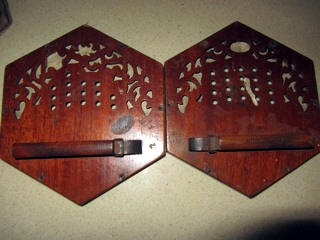 |
[Note: A440 + 63 cents = A456.3Hz - about as high as "Old
Philharmonic Pitch" ever went.]
So, with all that out of the way, let's get into some measurements.....
Reed length
We look first at the lengths
of the reeds, or more precisely, the lengths of the slots the reeds
operate in. It's much easier to measure the slots than the reeds,
and quite good enough for our purposes (there is only a tiny clearance
between the tip of the reed and the end of the slot).
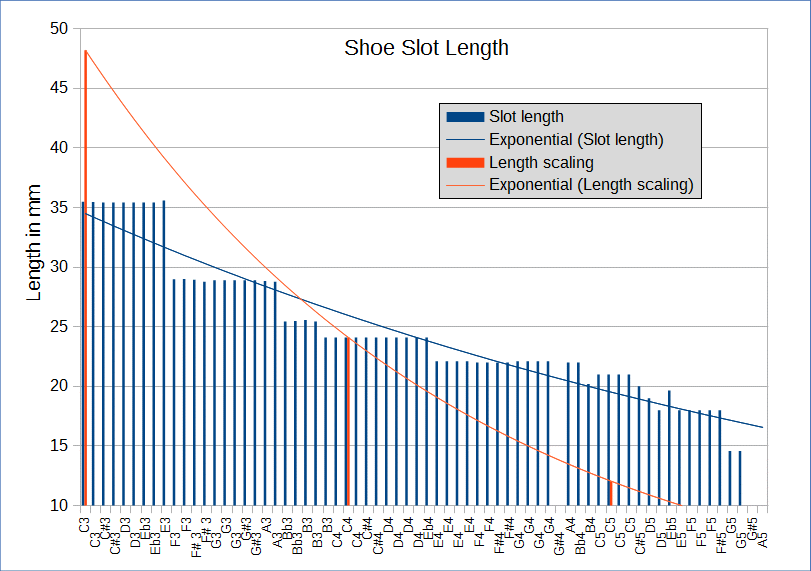
We can see, depending on how you interpret a few intermediate lengths,
that there are about 10 reed lengths employed, although most of the
reeds fall into 7 categories. I've put in a trend line (thin blue) to
illustrate the general slope followed.
I've also illustrated what the slope (thin orange trend line) would be
if the reeds followed the theoretical lengths, i.e. doubling in length
each time you go down an octave. As you can see, the bass reeds would
be much longer (and therefore harder to fit into the instrument) and the
treble reeds much shorter (and therefore quieter and less responsive).
But having stepped away from theoretical scaling, the laws of physics
demand we make adjustments elsewhere. We should keep a lookout for
where these compensations are made as we go through the other parameters
of the reeds.
Reed shoe thickness
While we're on the topic of the reed shoes, we also looked at the shoe
thickness. A confusing picture emerged:
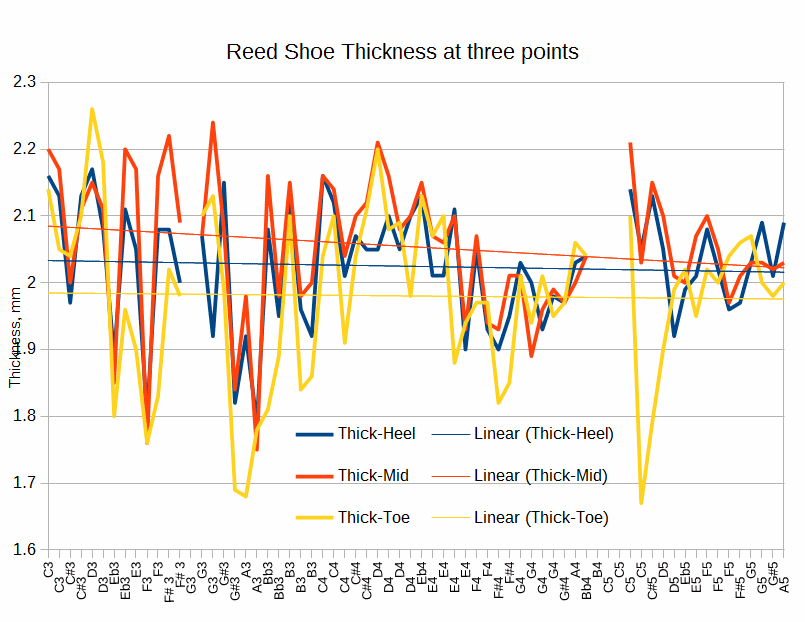
It's very hard to see any pattern emerging. David's feeling is: "seems
to be a product of uneven rolling, uneven pressing and varied sheets of
metal stamped".
Probably good to keep in mind that the nominal thickness is probably
2.08mm, 14 gauge.
Reed Widths
Now we move on to reed widths. The blue columns indicate the reed
width at their tips; the orange at the base.
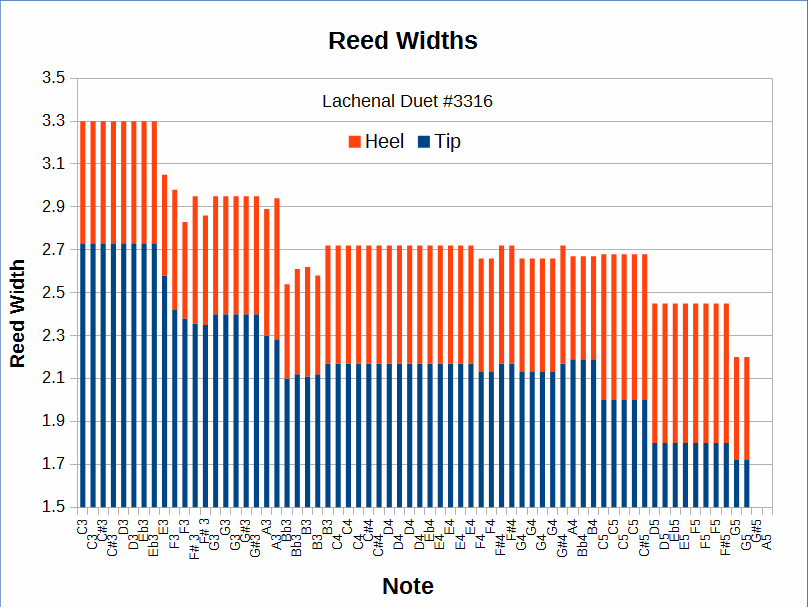
Once again, we find they are not incrementally scaled, but in about 5
tiers, for practical reasons. Note that over half the reeds are in the
middle tier. Reed width is not something that needs to be scaled
incrementally, but some tweaking is clearly called for over the range.
Reed Thickness
On to reed thickness, and, firstly, the general overview:
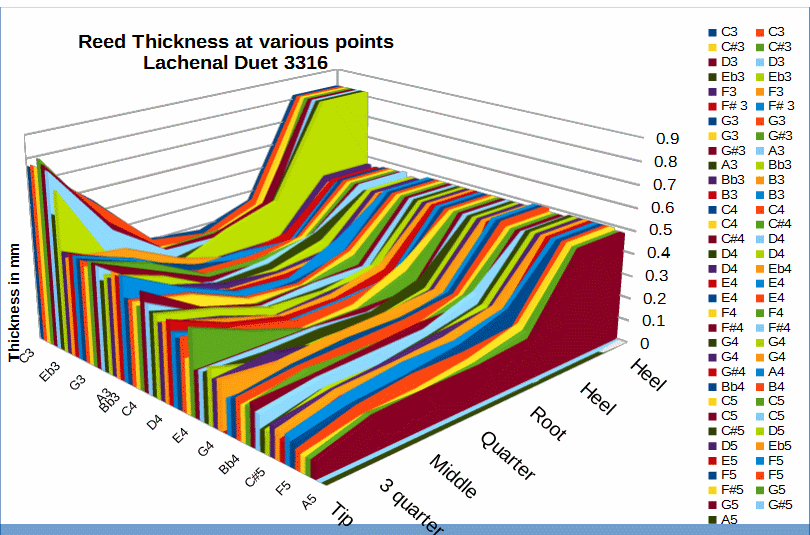
Treble reeds on the bottom right, bass reeds upper left. Heels at the
back right, tips at the front left. Note, I've duplicated the heel
measurement to illustrate the stock thickness under the clamp.
-
We can see that most of the reeds are made from
thinner stock, around 0.48mm, with the lower bass reeds cut from
0.82mm stock.
-
All
reeds are thinned, compared to the starting stock. It is perhaps
surprising that thinner stock isn't used as the starting point for
treble reeds to save the need for so much profiling.
-
Treble reeds are thinned most of the way, and are thinner at their
tips than anywhere else, sharpening their pitch.
-
Midrange reeds use tip mass to slow them down, lowering the pitch.
-
Bass
reeds make use of their thicker stock primarily by using it for
increased tip mass.
There's probably more we could deduce from this graph, but it might be
more easily seen on one of our alternative thickness graphs.
Reed Thickness, continued....
The 3D Overview is fun, but it's hard to appreciate all it's trying to
tell us. So let's look at the simpler 2D version...
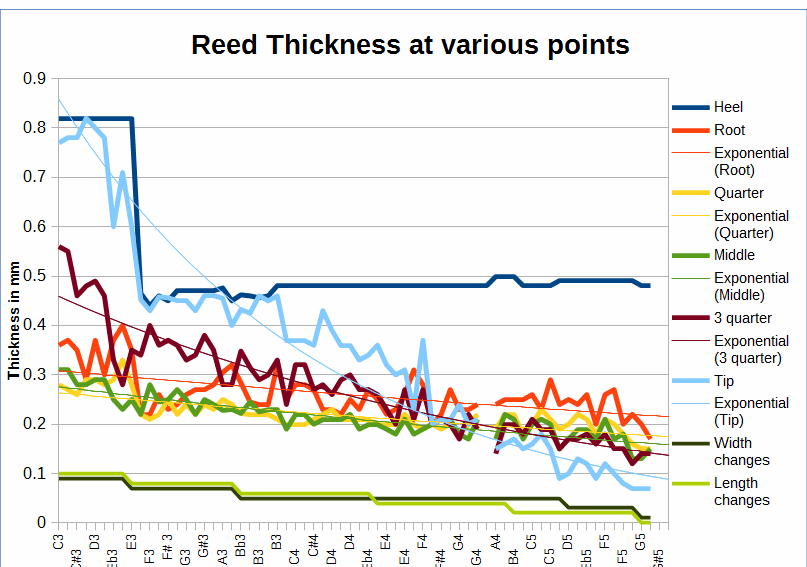
Some observations:
-
the navy trace is the heel, the section of reed under
the clamp. Confirms just two thicknesses of stock used in this
instrument.
-
the
G#4 reed is missing, hence the hole in the data at that point.
-
you'll
see I've provided trend lines for the other data (thin lines) to
alert us to where the maker was forced or happened to deviate from
the trend.
-
the
middle of the reeds and the quarter-point nearer the heel (green and
yellow respectively) vary least across the range. The variation is
from about +50% in the bass to around -30% in the treble, a total of
80%. That's small when we consider the frequency range is about
700%.
-
the
roots of the reeds also vary to about the same extent (the orange
trend line is parallel to the green and yellow), but are all
slightly thicker, as they transition up towards the heels.
-
the
middle, quarter and, to a slightly lesser extent, the root form the
belly of the reed - the section over which it bends.
-
the
big determinant in this system is the tip of the reeds, in aqua. It
varies from bass to treble over a 10:1 ratio, or 1000% - more than
the ratio of frequencies. So the tips of the reeds are doing most
of the heavy lifting. They are at full thickness in the bass, where
their weight is needed to pull the reeds down to pitch (remember
that the reeds didn't vary in length to the full extent science
would have liked). And they are ground right down to
next-to-nothing in the treble, where the reeds have been made longer
than ideal, in order to meet other practical requirements.
-
The
three-quarter point (in brown) also comes into play, but not to such
a degree - around 500% to put a number on it. Not only is it
transitional between middle and tip, it also changes role as we go
up the scale. In the bass reeds, it joins the tip as being part of
the weighting system. In the treble reeds, it becomes part of the
bending system.
-
When
we compare the thick aqua data trace with its thin trend line, we
spot an area of divergence which will repay closer attention. We
can see that the reeds from F3 to A3 would probably have preferred
to be made from the thicker stock (or stock of an intermediate
thickness). When you interpose a compromise in a musical system,
you have to compensate somewhere else. We might have thought the
logical place to compromise for lack of tip thickness would have
been at the three-quarter point, but the brown trace remains on
trend in that area. But check out the orange root trace - it dips
dramatically to save the day. The reed-tuner, finding that the
reeds are too sharp has flattened them by filing down the root more.
Can't increase weight? Increase flexibility. (Heh heh, I might
have been tempted to reach for the soldering iron...)
Reed
thickness, some more....
There's always another way to look at things, of course, and reeds are
no exception. If we look down the other axis in our 3D Overview, we get
an impression of how each reed is profiled. Of course, with so many
reeds, that can get a bit busy, but even so, we can make out a few
interesting points:
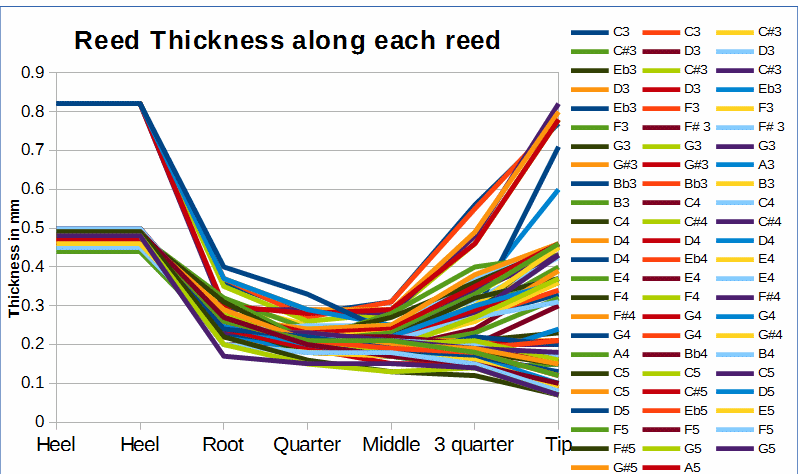
It's easy to see, on the left, that we have two stock thicknesses,
plunging downward then into the bellied region, and then radiating out
from the middles to the tips either upwards, if we're looking at a bass
reed, downward for a treble reed, or somewhere in between for the
midrange reeds. Perhaps, I'd hope to see a more even spread in the
radiation? We do have to remember that this work is being carried out
by human beings, not robots. And probably outworkers with less than
remarkable facilities at that. And we've already discussed that the
decision to use only two stock thicknesses means that some fudging is
going to be needed in the bellies department.
We do see a few reeds which look a little suspicious - eg the two shades
of blue at the top of the root column. They appear to reach their
minimum thickness over at middle, while most of the reeds have bottomed
out by the first quarter. I suspect they are the two Eb3 reeds - if you
look back at the other 2D view, you'll see there are some shenanigans
going on there at Eb3.
Getting it all together
It struck
me that it would be instructive to be able to view the reed thickness,
width and length all on one graph, as these all contribute to the reed's
tuning. Width and length are not incremental in the concertina - they
are, for practical reasons, varied in tiers. But thickness is
infinitely variable (within the limits of stock thickness!) and so it
must fall to thickness to make up for the rigidities of the other two
parameters. So we should be particularly interested in what happens to
thickness at the changeover points in the lengths and widths.
Trying to
display so much data on one graph presents problems, so this attempt
simply assigns fake values to width and length. But it does enable us
to see where the changes are happening, which is our main aim. Keep in
mind these are not to scale; indeed I've managed their values to
maximise clarity. It's their location and direction that we're
interested in.

You'll see
the new information as the two lowest traces on the graph above. Sure
enough, looking up from any of these changes we can usually see sudden
jerks in one or more of the thickness curves, as the reed tuner deftly
swerves to avoid an oncoming tuning issue. The laws of physics seem
still to be working....
Note
though, the biggest cat among the pigeons still remains the sudden 41%
reduction in stock thickness, which we dealt with earlier. Had the
concertina continued to exist, it would have been interesting to compare
the sounds of the two reeds on each side of that change. It's a big
change to ask the reed tuner to deal with.
Conclusions
That's probably enough rabbiting on by me. By now,
you'll be becoming aware of the dangers to mental health posed by
excessive indulgence in
forensic organology.
We do have to keep in mind that this is one set of reeds
for one make and one type of concertina made on one day by one man in a
hurry. We shouldn't view it as indicative of the broad range of
concertinas out there. It may well be, but we can't tell from here.
It would be great to have a "bank" of this kind of
information, covering at least the major makers and models, and ideally
covering their best periods. (Their worst might be more fun!) I'm
happy to help anyone who has or could take a set of data to present it
visually. Even a partial data set is better than none.
A reminder that if you want to follow the full journey,
including comments by many more knowledgeable than we, you can find it
here.
Acknowledgements
Thanks to David Hornett, for
putting so much effort into the measurements. And to those on
concertina.net who put up with us!
|